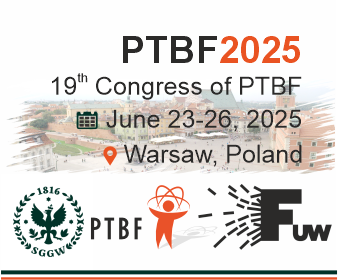SEMINARIUM Z FIZYKI BIOLOGICZNEJ I BIOINFORMATYKI
Instytutu Biochemii i Biofizyki PAN, Instytutu Fizyki PAN,
i Zakładu Biofizyki UW
Wednesday, 19.04.2023, 15:15
https://zoom.us/j/91976153012?pwd=azNiMWE4UnhPN3lRQlY2UHZHOXVkQT09
„A computational microscope to study co-translational protein folding”
Dr Tomasz Włodarski
Department of Structural and Molecular Biology
University College London, UK
Bogdan Lesyng (UW)
Anna Niedźwiecka (IF PAN)
Piotr Zielenkiewicz (IBB)
————————-
Meeting ID: 919 7615 3012
Passcode: 747922
One tap mobile
+48223073488,,91976153012#,,,,*747922# Poland
+48223987356,,91976153012#,,,,*747922# Poland
Dial by your location
+48 22 307 3488 Poland
+48 22 398 7356 Poland
+48 22 306 5342 Poland
————————-
Abstract
Proteins gain their functional structure in the process of protein folding.
Most proteins begin to fold co-translationally on the ribosome while they
emerge from its exit tunnel during protein biosynthesis. This is a
fundamental process for maintaining cellular proteostasis, failure of which
results in polypeptide misfolding and diseases such as Parkinson’s,
Alzheimer’s or other proteinopathies. Despite its importance, it remains
poorly understood as it is a significant challenge to obtain
high-resolution structural data of co-translational protein folding (coTF)
using structural biology methods alone; particularly the description of the
folding pathways is missing. Consequently, the use of accurate and
efficient computational techniques, especially in combination with NMR and
cryo-EM experimental data used as restraints, for reweighting or
validation, is imperative for a detailed understanding of protein folding
in the cell. In this presentation, I will describe an integrative
structural biology approach to study co-translational protein folding,
combining bioinformatics, all-atom and coarse-grained molecular dynamics
(MD) simulations with structural restraints from various experimental data
(NMR chemical shifts, RDCs and cryo-EM maps) and applied it to provide a
high-resolution description of snapshots of the protein biosynthesis. I
will present the characterisation of the dynamics and interactions of both
folded and intrinsically disordered nascent chains on the wild-type
bacterial ribosome and the rationally designed ribosome based on
bioinformatics analysis. Finally, I will provide the first structural
insights into the co-translational folding intermediate that were
experimentally confirmed and are the first step to fully characterising the
co-translational folding pathway.





